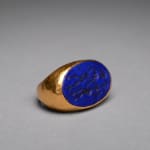Gold Ring with Classical Revival Lapis Intaglio of an Erotic Scene, 18th Century CE - 19th Century CE
Lapis and Gold
FJ.6883
The brilliant bold blues in paintings from the Renaissance are thanks to the natural hue of lapis lazuli, the blue rock loved by the ancients, from Mesopotamia, to Egypt, to...
The brilliant bold blues in paintings from the Renaissance are thanks to the natural hue of lapis lazuli, the blue rock loved by the ancients, from Mesopotamia, to Egypt, to Persia, to Greece and Rome. Traditionally one of the most rare and treasured of all gemstones, lapis lazuli was the prize of kings and is where the term “royal blue” derives. The ancient city of Ur had a thriving trade in lapis as early as the fourth millennium B.C. The name is international, from the Latin, lapis, which means stone, and from the Arabic, azul, which means blue.
The art of glyptics, or carving on colored precious stones, is probably one of the oldest known to humanity. Intaglios, gems with an incised design, were made as early as the fourth and third millennia B.C. in Mesopotamia and the Aegean Islands. They exhibit a virtuosity of execution that suggests an old and stable tradition rooted in the earliest centuries. The tools required for carving gems were simple: a wheel with a belt-drive and a set of drills. A special difficulty of engraving intaglios, aside from their miniature size, was that the master had to work with a mirror-image in mind.
With the discoveries of archaeological sites in Egypt and Italy, interest in the Classics was renewed during the 18th and 19th centuries, a period known as the Classical Revival. This interest swept through Europe and over the years, ancient art forms were brought back and the forgotten skills were slowly relearned. This intaglio seal carved out of precious lapis lazuli is a gorgeous testament to the era fascination with the past. The erotic scene carved on the polished surface of the stone is surely more in keeping with themes of the Classical era than the Victorian. This gorgeous ring evokes the beauty and luxury of the Classical world after which it was inspired.
The art of glyptics, or carving on colored precious stones, is probably one of the oldest known to humanity. Intaglios, gems with an incised design, were made as early as the fourth and third millennia B.C. in Mesopotamia and the Aegean Islands. They exhibit a virtuosity of execution that suggests an old and stable tradition rooted in the earliest centuries. The tools required for carving gems were simple: a wheel with a belt-drive and a set of drills. A special difficulty of engraving intaglios, aside from their miniature size, was that the master had to work with a mirror-image in mind.
With the discoveries of archaeological sites in Egypt and Italy, interest in the Classics was renewed during the 18th and 19th centuries, a period known as the Classical Revival. This interest swept through Europe and over the years, ancient art forms were brought back and the forgotten skills were slowly relearned. This intaglio seal carved out of precious lapis lazuli is a gorgeous testament to the era fascination with the past. The erotic scene carved on the polished surface of the stone is surely more in keeping with themes of the Classical era than the Victorian. This gorgeous ring evokes the beauty and luxury of the Classical world after which it was inspired.



